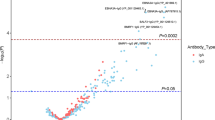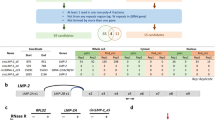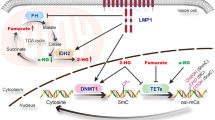Abstract
The nasal type, extranodal natural killer or T(NK/T)-cell lymphoma is usually associated with latent Epstein–Barr virus (EBV) infection. In order to elucidate the EBV gene expression patterns in vivo, we examined eight patients with cutaneous EBV-related NK/T-cell lymphomas, including six patients with a NK-cell phenotype and two patients with a T-cell phenotype. The implication of EBV in the skin lesions was determined by the presence of EBV-DNA, EBV-encoded nuclear RNA (EBER) and a clonality of EBV-DNA fragments containing the terminal repeats. Transcripts of EBV-encoded genes were screened by reverse transcription- polymerase chain reaction (RT-PCR), and confirmed by Southern blot hybridization. The expression of EBV-related antigens was examined by immunostaining using paraffin-embedded tissue sections and cell pellets of EBV-positive cell lines. Our study demonstrated that all samples from the patients contained EBV nuclear antigen (EBNA)-1 mRNA which was transcribed using the Q promoter, whereas both the Q promoter and another upstream promoter (Cp/Wp) were used in EBV-positive cell lines, B95.8, Raji and Jiyoye. Latent membrane protein-1 (LMP-1) mRNA was detected in seven of eight patients and all cell lines, whereas EBNA-2 transcripts were found only in the cell lines. Immunostaining showed no LMP-1, EBNA-2 or ZEBRA antigens in the paraffin-embedded tissue sections, although they were positive in the cell line cells. Latent BHRF1 transcripts encoding bcl-2 homologue and BCRF1 transcripts encoding viral interleukin (vIL)-10 were detected in one and two of eight patients, respectively. A patient with NK-cell lymphoma expressing both transcripts died of rapid progression of the illness. Our results indicate that the restricted expression of the latency-associated EBV genes and the production of vIL-10 and bcl-2 homologue may favour tumour growth, evading the host immune surveillance. © 2001 Cancer Research Campaign
Similar content being viewed by others

Article PDF
Change history
16 November 2011
This paper was modified 12 months after initial publication to switch to Creative Commons licence terms, as noted at publication
References
Blay JY, Burdin N, Rousset F, Lenoir G, Biron P, Philip T, Banchereau J and Favrot MC (1993) Serum interleukin-10 in non-Hodgkin's lymphoma: a prognostic factor. Blood 82: 2169–2174
Brooks L, Yao QY, Rickinson AB and Young LS (1992) Epstein–Barr virus latent gene transcription in nasopharyngeal carcinoma cells: coexpression of EBNA1, LMP1, and LMP2 transcripts. J Virol 66: 2689–2697
Chan JKC, Sin VC, Wong KF, Ng CS, Tsang YW, Chan CH, Cheung MMMC and Lau WH (1997) Nonnasal lymphoma expressing the natural killer cell marker CD56: a clinicopathologic study of 49 cases of uncommon aggressive neoplasm. Blood 89: 4501–4513
Cohen JL and Lekstrom K (1999) Epstein–Barr virus BARF1 protein is dispensable for B-cell transformation and inhibits alpha interferon secretion from mononuclear cells. J Virol 73: 7627–7632
Deacon EM, Pallesen G, Niedobitek G, Crocker J, Brooks L, Rickinson AB and Young LS (1993) Epstein–Barr virus and Hodgkin's disease: transcriptional analysis of virus latency in the malignant cells. J Exp Med 177: 339–349
Fahraeus R, Rumo L, Rhim JS and Klein G (1990) Morphological transformation of human keratinocytes expressing the LMP gene of Epstein–Barr virus. Nature 345: 447–449
Hamilton-Dutoit SJ, Rea D, Raphael M, Sandvej K, Delecluse HJ, Gisselbrecht C, Marelle L, van Krieken HJ and Pallesen G (1993) Epstein–Barr virus-latent gene expression and tumour cell phenotype in acquired immunodeficiency syndrome-related non-Hodgkin's lymphoma. Correlation of lymphoma phenotype with three distinct patterns of viral latency. Am J Pathol 143: 1072–1085
Harabuchi Y, Yamanaka N, Kataura A, Imai S, Kinoshita T, Mizuno F and Osato T (1990) Epstein-Barr virus in nasal T-cell lymphomas in patients with lethal midline granuloma. Lancet 335: 128–130.
Harris NL, Jaffe ES, Diebold J, Flandrin G, Muller-Hermelink K, Vardiman J, Lister TA and Bloomfield CD (1999) World Health Organization Classification of neoplastic diseases of the hematopoietic and lymphoid tissues: Report of the Clinical Advisory Committee Meeting – Airlie House, Virginia, November 1997. J Clin Oncol 17: 3835–3849
Henderson S, Rowe M, Gregory C, Croom-Carter D, Wang F, Longnecker R, Kieff E and Rickinson A (1991) Induction of bcl-2 expression by Epstein–Barr virus latent membrane protein 1 protects infected B cells from programmed cell death. Cell 65: 1107–1115
Henderson S, Huen D, Rowe M, Dawson C, Johnson G and Rickinson A (1993) Epstein–Barr virus-coded BHRF1 protein, a viral homologue of Bcl-2, protects human B cells from programmed cell death. Proc Natl Acad Acad Sci USA 90: 8479–8483
Hsu DH, Malefyt RDW, Fiorentino DF, Dang MN, Vieira P, deVries J, Spits H, Mosmann TR and Moore KW (1990) Expression of Interleukin-10 activity by Epstein–Barr virus protein BCRF1. Science 250: 830–832
Hudson GS, Bankier SC, Satchwell and Barrell BG (1985) The short unique region of the B95.8 Epstein–Barr virus genome. Virology 147: 81–85
Iwatsuki K, Ohtsuka M, Harada H, Han G and Kaneko F (1997) Clinicopathologic manifestations of Epstein–Barr virus-associated cutaneous lymphoproliferative disorders. Arch Dermatol 133: 1081–1086
Jaffe ES, Costa J, Fauci AS, Cossman J and Tsokos M (1983) Malignant lymphoma and erythrophagocytosis simulating malignant histiocytosis. Am J Med 75: 741–749
Jaffe ES, Chan JKC, Su IJ, Frizzera G, Mori S, Feller AC and Ho FCS (1996) Report of the workshop on nasal and related extranodal angiocentric T/natural killer cell lymphomas. Am J Surg Pathol 20: 103–111
Kerr BM, Lear AL, Rowe M, Croom-Carter D, Young LS, Rookes SM, Gallimore PH and Rickinson AB (1992) Three transcriptionally distinct forms of Epstein–Barr virus latency in somatic cells hybrids: cell phenotype dependence of viral promotoer usage. Virology 187: 189–201
Levitskaya J, Coram M, Levitsky V, Imreh S, Steigerwald-Mullen PM, Klein G, Kurilla MG and Masucci MG (1995) Inhibition of antigen processing by the internal repeat region of Epstein–Barr virus nuclear antigen-1. Nature 375: 685–688
Miller G (1990) The switch between latency and replication of Epstein–Barr virus. J Infect Dis 161: 833–844
Miyazaki I, Cheung RK and Dosch HM (1993) Viral interleukin 10 is critical for the induction of B cell growth transformation by Epstein–Barr virus. J Exp Med 178: 439–447
Moore KW, Vieira P, Fiorentino DF, Trounstine ML, Khan TA and Mosmann TR (1990) Homology of cytokine synthesis inhibitory factor (IL-10) to the Epstein–Barr virus gene BCRF1. Science 248: 1230–1234
Ohtsuka M, Iwatsuki K, Kaneko R, Akiba H, Kikuchi S, Harada H and Kaneko F (1999) Epstein–Barr virus-associated lymphoid hyperplasia of the eyelid characterized by intramuscular infiltration. Br J Dermatol 140: 358–359
Oudejans JJ, Jiwa M, van den Brule AJC, Grasser FA, Horstman A, Vos W, Kluin PM, van der Valk P, Walboomers JMM and Meijer CJLM (1995a) Detection of heterogeneous Epstein–Barr virus gene expression patterns within individual post-transplanation lymphoproliferative disorders. Am J Pathol 147: 923–933
Oudejans JJ, van den Brule AJC, Jiwa NM, de Bruin PC, Ossenkoppele GJ, van der Valk P, Walboomers JMM and Meijer CJLM (1995b) BHRF1, the Epstein–Barr virus (EBV) homologue of the Bcl-2 proto-oncogene, is transcribed in EBV-associated B-cell lymphomas and in reactive lymphocytes. Blood 86: 1893–1902
Raab-Traub N and Flynn K (1986) The structure of the termini of the Epstein–Barr virus as a marker of clonal cellular proliferation. Cell 47: 883–889
Rickinson AB, Young LS and Rowe M (1987) Influence of the Epstein–Barr virus nuclear antigen EBNA2 on the growth phenotype of virus-transformed B cells. J Virol 61: 1310–1317
Rowe M, Rowe DT, Gregory CD, Young LS, Farrell PJ, Rupani H and Rickinson AB (1987) Differences in B cell growth phenotype reflect novel patterns of Epstein–Barr virus latent gene expression in Burkitt's lymphoma cells. EMBO J 6: 2743–2751
Sample J, Brooks L, Sample C, Young LS, Rowe M, Gregory C, Rickinson AB and Kieff E (1991) Restricted Epstein–Barr virus protein expression in Burkitt lymphoma is due to a different Epstein–Barr nuclear antigen 1 transcriptional initiation. Proc Natl Acad Sci USA 88: 6343–6347
Schaefer BC, Woisetschlaeger M, Strominger JL and Speck SH (1991) Exclusive expression of Epstein–Barr virus nuclear antigen 1 in Burkitt lymphoma arises from a third promoter, distinct from the promoters used in latently infected lymphocytes. Proc Natl Acad Sci USA 88: 6550–6554
Su IJ and Hsieh HC (1992) Clinicopathological spectrum of Epstein–Barr virus-associated T cell malignancies. Leukemia Lymphoma 7: 47–53
Su IJ, Hsieh HC, Lin KH, Kao WCL, Chen CL, Cheng AL, Kadin ME and Chen JY (1991) Aggressive peripheral T-cell lymphoma containing Epstein–Barr virus DNA: A clinical, pathologic and molecular analysis. Blood 77: 799–808
Sugiura M, Imai S, Tokunaga M, Koizumi S, Uchizawa M, Okamoto K and Osato T (1996) Transcription analysis of Epstein–Barr virus gene expression in EBV positive gastric carcinoma: unique viral latency in the tumour cells. Br J Cancer 74: 625–631
Tao Q, Robertson KD, Manns A, Hildesheim A and Ambinder RF (1998) Epstein–Barr virus in endemic Burkitt's lymphoma: molecular analysis of primary tumour tissue. Blood 91: 1373–1381
Wang D, Liebowitz D and Kieff E (1985) An EBV membrane protein expressed in immortalized lymphocytes transforms established rodent cells. Cell 43: 831–840
Xu ZG, Iwatsuki K, Ohtsuka M, Oyama N, Matsui T and Kaneko F (2000) Polymorphism analysis of Epstein–Barr virus isolates from patients with cutaneous NK/T-cell lymphoproliferative disorders: a possible relation to the endemic occurrence of these diseases in Japan. J Med Virol 62: 239–246
Young LS, Alfieri C, Hennessy K, Evans H, Ohara C, Anderson KC, Ritz J, Shapiro RS, Rockinson A and Kieff E (1989) Expression of Epstein–Barr virus transformation-associated genes in tissues of patients with EBV lymphoproliferative disease. N Engl J Med 321: 1080–1085
Zeidler R, Eissner G, Meissner P, Uebel S, Tamp R, Lazis S and Hammerschmidt W (1997) Downregulation of TAP1 in B lymphocytes by cellular and Epstein–Barr virus-encoded interleukin-10. Blood 90: 2390–2397
Author information
Authors and Affiliations
Additional information
Correspondence to: K Iwatsuki; Email: keijiiwa@fmu.ac.jp
Rights and permissions
From twelve months after its original publication, this work is licensed under the Creative Commons Attribution-NonCommercial-Share Alike 3.0 Unported License. To view a copy of this license, visit http://creativecommons.org/licenses/by-nc-sa/3.0/
About this article
Cite this article
Xu, ZG., Iwatsuki, K., Oyama, N. et al. The latency pattern of Epstein–Barr virus infection and viral IL-10 expression in cutaneous natural killer/T-cell lymphomas. Br J Cancer 84, 920–925 (2001). https://doi.org/10.1054/bjoc.2000.1687
Received:
Revised:
Accepted:
Published:
Issue date:
DOI: https://doi.org/10.1054/bjoc.2000.1687
Keywords
This article is cited by
-
Molecular pathogenic pathways in extranodal NK/T cell lymphoma
Journal of Hematology & Oncology (2019)
-
Defective Epstein–Barr virus in chronic active infection and haematological malignancy
Nature Microbiology (2019)
-
Icaritin induces lytic cytotoxicity in extranodal NK/T-cell lymphoma
Journal of Experimental & Clinical Cancer Research (2015)
-
Genotypic analysis and latent membrane protein 1 expression of Epstein-Barr virus in extranodal NK/T-cell lymphoma from Northern Chinese patients
Archives of Virology (2015)
-
Deciphering the role of Epstein-Barr virus in the pathogenesis of T and NK cell lymphoproliferations
Herpesviridae (2011)


